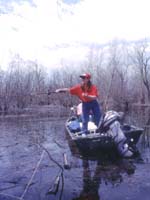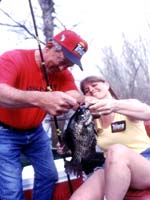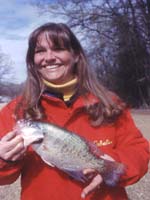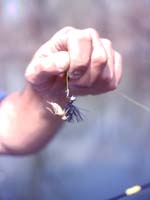
|
Features
|
|
|
|
Books
|
|
|
|
Fun & Games
|
|
|
|
Contact Us
|
|
|
Night Hawk Stories... Entry 32
The Crappie Dawg And The Pup
by John E.
Phillips
Page 2
Boats For Fishing Cut-offs and Oxbows
 The
Crappie Dawg can pinpoint big slab crappie when most other anglers can't
because he fishes where many anglers can't fish.
The
Crappie Dawg can pinpoint big slab crappie when most other anglers can't
because he fishes where many anglers can't fish.
"I use a narrow, aluminium johnboat to get inside the willow thickets and move through the willows to the back side where no one else fishes," Weldon mentioned.
A small, lightweight, narrow boat also enables Weldon to go through and over log jams and slide across the top of mud flats to where most conventional anglers never get to fish. "Most crappie fishermen don't fish shallow enough to catch big crappie," Weldon commented. "When crappie come in to spawn, they're looking for shallow water. In most oxbows, shallow water can be found on the back side of brush, cover, grass or at Tunica, the willows. The closer we get to spawning time, the closer the crappie will move into the bank and the deeper you have to go into the willows to find the shallow water."
 Also,
as the water warms up, the crappie move to the surface to feed. So even
though sometimes Weldon may fish in water that's 6 to 10 feet deep, he'll
keep his jig and cricket only 2 to 4 feet under the water.
Also,
as the water warms up, the crappie move to the surface to feed. So even
though sometimes Weldon may fish in water that's 6 to 10 feet deep, he'll
keep his jig and cricket only 2 to 4 feet under the water.
On Weldon's best day of crappie fishing in the Tunica Cut-off, he and a friend caught 50 crappie that weighed 75 pounds. "The Tunica Cut-off produces plenty of big crappie because it's on the lower end of the Mississippi drainage," Weldon reported. "All the fertilizers and nutrition that flow down the Mississippi are deposited into the Cut-off. Because of this, the lake has extremely fertile soils around it, contains very fertile water and enjoys a long growing season, all factors conducive to growing big crappie."
Crappie Locations In The Off-Season
 Most
people only fish for crappie during the spring run, but the Crappie Dawg
of Tunica, Mississippi, catches crappie all year, even in extremely hot
or cold weather.
Most
people only fish for crappie during the spring run, but the Crappie Dawg
of Tunica, Mississippi, catches crappie all year, even in extremely hot
or cold weather.
Weldon explained that "when the crappie begin to move into the shallows during March and April, I start catching them on the outside of the willow trees. Then I follow them all the way to the shallow water right up against the bank when they're spawning. After they're finished spawning, the crappie migrate out of the willows the same way they've come in, and they move out into the deep holes and channels in the lake. During very hot or extremely cold weather, I still catch plenty of big crappie trolling these channels."
Weldon has different trolling tactics from most anglers. Although a crappie fisherman will troll only one jig on the end of a line, Weldon will troll as many as five. "I'm usually trolling water that is 12 to 14 feet deep. So, I'll tie one jig on my line at 14 feet, one at 13, one at 12, one at 10 and one at 9. By having jigs tied on at different depths, I can be sure I have a jig passing through the crappie's strike zone -- no matter what the weather. With this strategy, I can pinpoint at what depth the crappie want to feed during that particular day, and then I may tie on all my jigs at that depth."
 The
Crappie Dawg, who takes crappie by using techniques that most crappie
fishermen don't and by fishing in places most fishermen won't or can't
fish, also fishes with the "Pup," an angler from Cordova, Tennessee, by
the name of Kent Driscol, during the spring of the year.
The
Crappie Dawg, who takes crappie by using techniques that most crappie
fishermen don't and by fishing in places most fishermen won't or can't
fish, also fishes with the "Pup," an angler from Cordova, Tennessee, by
the name of Kent Driscol, during the spring of the year.